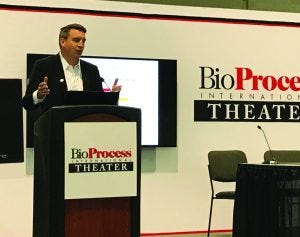- Sponsored Content
- Contract Services
Bringing Biologic Products to Market Faster By Partnering with a Single Services Provider from Development Through Commercial SupplyBringing Biologic Products to Market Faster By Partnering with a Single Services Provider from Development Through Commercial Supply
August 21, 2018
Sponsored by Catalent
 Andrew Sandford, vice president of business development, Catalent Biologics
Andrew Sandford, vice president of business development, Catalent Biologics
Catalent feels strongly about “Patients First.” The core of the company’s mission is to “enhance and improve the lives of your patients.”
Bringing a new drug to market is expensive, costing about US$2.6 billion per drug. It takes an average of 12 years from drug discovery to final approval, with only 1 in 5,000 products ultimately approved by the Food and Drug Administration. The expense, risk, and long timelines of drug development are driving the search for efficiencies.
If you are working with multiple service providers that all offer different expertise, time and complexity will be added to your development. It is much more efficient to use one provider that can go from preclinical work to fill–finish and labeling and ultimately manufacturing a commercial product. Catalent is strictly a service provider with significant investment in people and capital. The company can start with a gene sequence, move to developing a cell line, accomplish process development, and commercially manufacture the product.
When choosing a service provider, consider its expertise, experience, business longevity, capability, and capacity and flexibility for working on your product. Find out how the provider handles problems and what its strategic abilities are for implementing the entire program.
Tufts University conducted a study assessing the economics of single-source and multivendor biomanufacturing (1). The resulting paper quantified the advantage of using a single service provider for two monoclonal antibodies (MAbs) at different phases of development. First, results showed significant time savings of 14 weeks for a phase 1 MAb to 18 weeks for a phase 3 MAb. Financially, production of the phase 3 MAb saved around $80 million, and the phase 1 MAb saved around $30 million.
Catalent has made some recent acquisitions, such as of Cook Pharmica, to further enable it to be a sole provider for companies of all sizes. Some of the company’s capabilities are cell-line engineering in the preclinical stage, biomanufacturing, analytical and laboratory services, fill–finish manufacturing and supply, and regulatory support. Its analytical department also can stand alone for companies who need only analytical support. Working with a single provider can bring life-changing and life-saving therapies to patients faster.
Reference
1 DiMasi JA, Smith Z, Getz KA. Assessing the Economics of Single-Source vs. Multi-Vendor Manufacturing. 2017. Tufts Center for the Study of Drug Development, Tufts University School of Medicine. Boston, MA. https://static1.squarespace.com/static/5a9eb0c8e2ccd1158288d8dc/t/5aa2ffa7c830258399bd dd82/1520631721090/DiMasi_17.pdf. (This study was supported in part by a grant from Patheon, Inc. The full study has been submitted for publication to a peer-reviewed journal.)
You May Also Like






